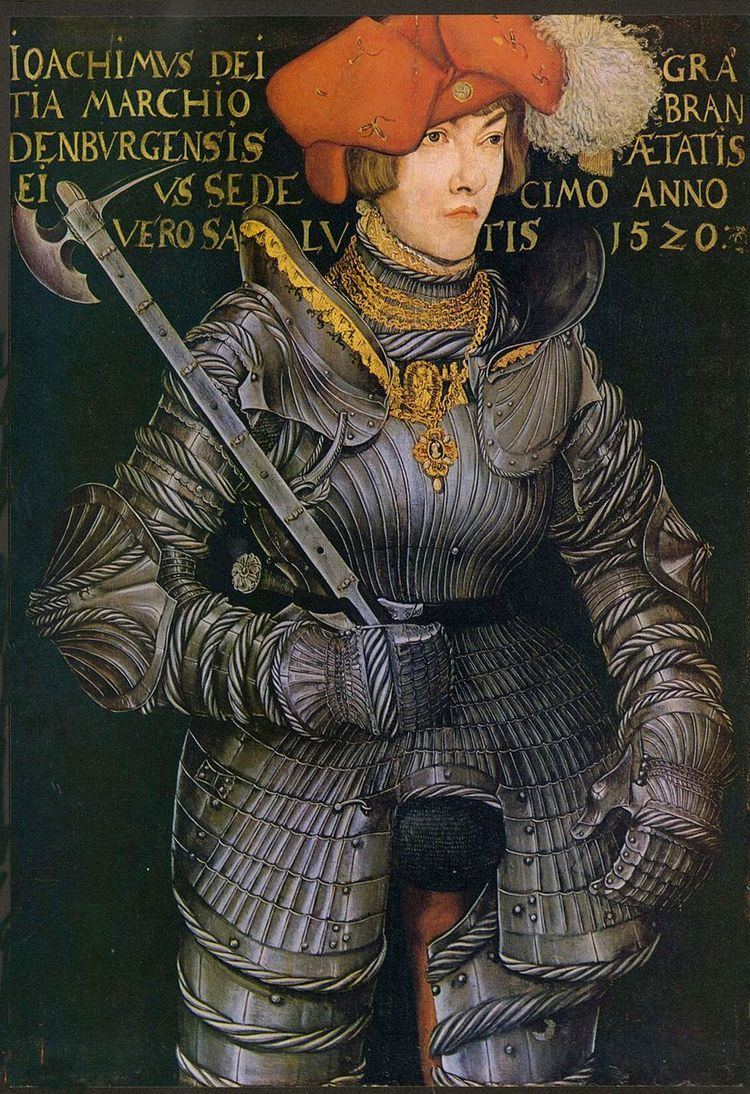Name Joachim Hector, | Role Prince | |
 | ||
Father Joachim I Nestor, Elector of Brandenburg Mother Elizabeth of Denmark, Norway, and Sweden Born 13 January 1505
Colln ( 1505-01-13 ) Died January 3, 1571, Kopenick, Germany Spouse Hedwig Jagiellon, Electress of Brandenburg (m. 1535), Magdalena of Saxony (m. 1524) Children John George, Elector of Brandenburg Parents Elizabeth of Denmark, Electress of Brandenburg, Joachim I Nestor, Elector of Brandenburg Grandchildren Erdmuthe of Brandenburg Similar People Joachim I Nestor - Elector of, John George - Elector of, John - Margrave of Brande, Albert of Mainz, George - Duke of Saxony | ||
Noble family House of Hohenzollern | ||
Joachim II (German: Joachim II Hector or Hektor; 13 January 1505 – 3 January 1571) was a Prince-elector of the Margraviate of Brandenburg (1535–1571), the sixth member of the House of Hohenzollern. Joachim II was the eldest son of Joachim I Nestor, Elector of Brandenburg and his wife Elizabeth of Denmark, Norway, and Sweden. He received the cognomen Hector after the Trojan prince and warrior for his athel qualities and prowess.
Contents
Biography
Joachim II was born in Cölln.
His father, Joachim I Nestor, made Joachim Hector sign an inheritance contract in which he promised to remain Roman Catholic. This was intended in part to assist Joachim Nestor's younger brother, the Archbishop-Elector Albert of Mainz. Albert had borrowed huge amounts from the banking house of Fugger in order to pay the Holy See for his elevation to the Prince-Bishopric of Halberstadt and for a dispensation permitting him to hold both the Archbishopric of Magdeburg and Archbishopric of Mainz.
Joachim Nestor, who had co-financed this accumulation of offices, agreed to let Albert recover these costs by the sale of indulgences to his subjects. Joachim's neighbor, Elector John Frederick I of Saxony, forbade the sale of indulgences, because Albert had outbid his candidate for the see of Mainz, but also on principle, being persuaded by his subject Martin Luther. Thus repayment of the debt to the Fugger depended on the sale of indulgences to Catholic believers in Brandenburg. However, had Joachim Hector not agreed to this, he would likely have been passed over in the line of inheritance.
His first marriage was to Magdalena of Saxony from the ducal Albertine line of the House of Wettin. She died in 1534.
In 1535 he married Hedwig, daughter of King Sigismund I the Old of Poland. As the Jagiellon dynasty was Catholic, Joachim II promised Sigismund that he would not make Hedwig change her religious affiliation. .
With the deaths of his father Joachim Nestor (1535) and father-in-law Sigismund (1548), Joachim turned gradually to the Protestant Reformation. On 1 November 1539, he received Communion under both kinds in Spandau's St. Nicholas' Church, an act that indicated a degree of sympathy with the new religious ideas. However, Joachim did not explicitly adopt Lutheranism until 1555, to avoid open confrontation with his ally, Emperor Charles V. Prior to this, Joachim promulgated a conservative church order that was Lutheran in doctrine, but retained many traditional religious institutions and observances, such as the episcopate, much of the Mass in Latin, religious plays and feast days.
In early 1539, at the diet of princes of imperial immediacy (Fürstentag) of the Holy Roman Empire in Frankfurt upon Main, Lutheran spokesman Philipp Melanchthon revealed to the gathered princes (among them Joachim) that the anti-Jewish pogroms of 1510 in Brandenburg had been based on a feigned host desecration. This pogrom had resulted in the expulsion of the Jews from Brandenburg. The Jewish advocate Josel von Rosheim, who was also in attendance, pleaded privately with Joachim to allow the Jews to settle in the Brandenburg again. Joachim acceded to this request on 25 June 1539.
His wife Hedwig's mother Barbara Zápolya was a sister of John Zápolya, who had claimed the vacant throne of Hungary after King Louis II was killed in battle against the Ottoman Empire in 1526. However, Joachim supported Ferdinand of Habsburg, who also claimed the crown and challenged the Turkish invaders. In 1542 Joachim assisted Ferdinand against the Ottomans at the Siege of Buda (1541). He commanded an army of Austrian, Hungarian, German, Bohemian, Italian, and Dalmatian troops, but the Elector was not a seasoned warrior and eventually beat a retreat. He was defeated again by the Ottomans in the Siege of Pest in 1542.
In 1545 Joachim held a gala double wedding celebration for his two children, John George and Barbara. They were married to Sophie and George, both children of the Piast Duke Frederick II of Liegnitz in Silesia.
Joachim was a brother-in-law of King Sigismund II Augustus of Poland. In 1569, he paid Sigismund for a deed of enfeoffment which made Joachim and his issue heirs to Ducal Prussia in case of the extinction of the Prussian Hohenzollern line.
In 1571, Joachim died in the Köpenick Palace, which he had built in 1558.
Marriages and Children
With Magdalena of Saxony (1507-1534):
With Hedwig Jagiellon (1513–1573):
